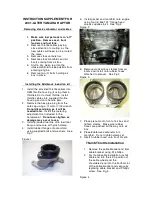
4-5. Operating other driving systems
188
WARINING
◼
To ensure driving safety, the occupants in the car must fasten their seat belts.
◼
AEB is only a driver assistance system, so do not over-rely on it and the driver
must drive carefully.
◼
AEB may not recognize modified or decorated vehicles with special appearance.
◼
On curved roads, hilly roads or unusually bumpy roads, the system may not be
able to detect vehicles ahead and drivers must drive with caution.
◼
AEB may not be able to identify targets such as cyclists.
◼
The braking function of the AEB system will not be activated when the electronic
stability control (ESC) system is off or malfunctioning.
◼
If it snows or rains heavily, the system may not work properly.
◼
For scenarios such as strong backlight, road reflection, and insufficient ambient
lighting, the AEB system may not work properly, so drivers should drive with
caution.
◼
If towing another vehicle or trailer, turn off the AEB system. The safety of the
vehicle deteriorates when the brakes are controlled under traction conditions.
◼
If the chassis of the car in front is very high, or the goods protrude from the back
of the car, please pay attention to the possible dangerous situation.
◼
The front windshield must not be modified or covered by any auxiliary equipment,
as this may result in reduced performance or failure of AEB!
◼
If the camera is displaced by a collision, the AEB function may be degraded or
malfunction, so the driver should calibrate the AEB system in time.
◼
Do not use an uncalibrated AEB system.
◼
The AEB system obtains vehicle information by identifying the rear of the vehicle,
so the system does not alert to oncoming traffic in the opposite direction or to
vehicles crossing laterally in front of it.
◼
The AEB system is a secondary system, but cannot detect the vehicle in all
situations. For example, vehicles with heavily obscured rear ends, vehicles with
strange shapes (e.g. overloaded vehicles transporting trees), vehicles with
heavily damaged rear ends, etc.
◼
When the vehicle is driving in a curve, AEB may not be able to accurately
determine the status of stationary objects in the direction of travel of the vehicle,
so the system may not perform active emergency braking assistance.
◼
The AEB system does not help the driver in all situations, so the driver must not
completely rely on the system and must concentrate on road conditions to ensure
safe driving.
◼
The AEB system is an active DAS, but it cannot fully prevent collision with
vehicles ahead in all situations. The driver needs to be responsible for how he or
she drives and how he or she avoids dangerous situations. In the event of an
emergency, the driver should apply the brakes as promptly as possible.
◼
If the AEB system is activated, when the vehicle is stopped, the driver must
control the vehicle in time to prevent the vehicle from starting again and causing
the vehicle to roll backwards.
Содержание E-HS9
Страница 2: ......
Страница 20: ...18 ...
Страница 65: ...1 3 Immobilizer system 63 Safety precautions 1 ...
Страница 211: ...4 6 Driving information 209 Driving 4 ...
Страница 305: ...6 4 Other in car equipment 303 In car equipment 6 ...
Страница 341: ...7 3 Self maintenance 339 Service and maintenance 7 ...
Страница 388: ...9 1 Specification Service data 386 List of abbreviations 386 Other information 385 ...
Страница 391: ...389 Charging station references Hood opening handle Charging port cover Tire pressure ...
















































